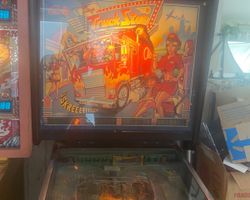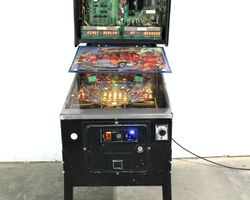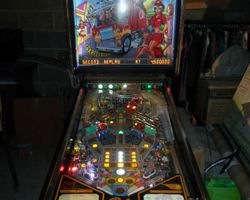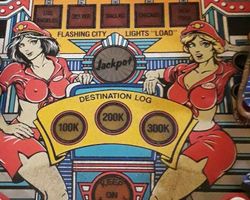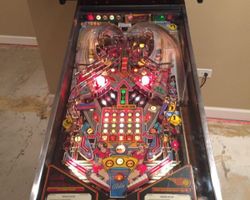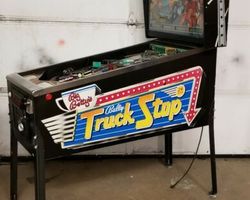Truck Stop
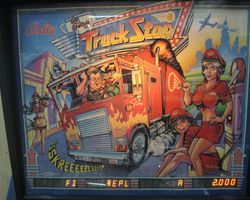
Average Prices: USD $400 to $1,100
Produced: November, 1988
Production Run: 1,598 units
Machine Type: Solid State Electronic
MPU: Bally MPU A084-91786-AH06 (6803)
Players: 4
Design by: Jim Patla, Dan Langlois, Steve Kirk
Art by: Pat McMahon
Mechanics by: Greg Tastad
Music by: Chris Granner
Sound by: Chris Granner
Truck Stop, a pinball machine released by Bally Manufacturing Co. in November 1988, emerges from a pivotal moment in pinball history. It represents one of the first machines to bear the Bally name following the significant merger with Williams Electronics, a union that blended distinct design philosophies and engineering approaches. This context is more than a mere footnote; it directly influenced the machine's construction and identity.
The concept for Truck Stop originated from a prototype known as "Ramp Warrior." The transformation from prototype to production machine saw the thematic evolution into a roadside diner and trucking setting, capturing a slice of Americana. The design team included Dan Langlois, Jim Patla, and Steve Kirk, who collectively shaped the game's fundamental layout and flow. For the visual identity, Greg Freres crafted the vibrant playfield and plastic artwork, while Pat McMahon was responsible for the distinctive backglass art. Chris Granner contributed the machine's sound and music, providing an auditory backdrop that became a signature element. Rehman Merchant handled the software, translating the designers' vision into interactive gameplay, and Greg Tastad was credited with the mechanical engineering. With a production run of approximately 1,598 units, Truck Stop became an accessible title during a transformative period for the manufacturer. One notable piece of trivia underscores the machine's unique genesis: its playfield prominently features a yellow traffic merge sign with the text "Williams/Bally Merge," a playful acknowledgment of the corporate integration. Another interesting detail concerns the choice of pinball size. Jim Patla recounted that a vendor error in the wire ramp dimensions meant that standard 1 1/16-inch pinballs would get stuck. To meet the trade show deadline, a pragmatic decision was made to use smaller, 1-inch diameter pinballs, a rare deviation from the industry standard, making Truck Stop the only Solid State machine specifically designed for this ball size.
Signature Features and Design
Truck Stop establishes its identity through a series of distinct features that enhance both its aesthetic and interactive elements. Central to its visual appeal are the truck running lights mounted atop the backbox. These lights flash dynamically during gameplay, mirroring the visual cues of a real truck, a touch that captivated players and added a unique flair to the game's presentation. On the playfield, one of the more striking elements is the presence of three in-line drop targets situated in an open, accessible area. This configuration of drop targets was less common on System 11-era games, providing a distinct tactical element to gameplay, as players aim to clear them for scoring opportunities or mode activation.
The absence of traditional pop bumpers is addressed by the inclusion of an upper set of slingshots. These slingshots serve to maintain ball motion and inject unpredictability into the upper playfield, ensuring the ball remains lively and challenging, even without the characteristic chaotic thumping of pop bumpers. Furthermore, the machine incorporates four ramps, a generous number for its era, which are integral to the gameplay experience. These ramps provide satisfying shot opportunities and contribute to the game's overall sense of flow. The artwork by Greg Freres on the playfield and plastics and Pat McMahon on the backglass immerses players in the truck stop theme, depicting detailed scenes of truckers, diners, and the open road, adorned with a vibrant palette that enhances the machine's inviting atmosphere.
Playfield and Mechanics
The playfield of Truck Stop presents a layout characterized by its symmetrical flow and an emphasis on ramp shots. Four distinct ramps dominate the upper half of the playfield, offering multiple routes for ball travel and contributing to a sense of journey aligned with the trucking theme. Major shots include direct access to these ramps, demanding precision from players to achieve repeatable success. The primary objective often involves shooting these ramps, which can lead to various scoring opportunities and activate game features.
Below the ramps, the three in-line drop targets are strategically positioned, requiring accurate shots to clear them sequentially. These targets contribute to spelling out words or advancing specific game objectives. The lower playfield features four flippers: two standard lower flippers for general playfield manipulation and two upper flippers positioned to access the higher ramps and targets, creating nuanced shot geometry. A unique mechanical feature is the outhole kicker, which, rather than simply draining the ball, propels it directly to an opposite kicker. This mechanism maintains a fast pace and keeps the action continuous, minimizing downtime between ball drains and new ball launches.
The artwork on the playfield is replete with detailed illustrations consistent with the truck stop theme. Diners, truck drivers, road signs, and the iconic "Williams/Bally Merge" sign near the ball launch area all contribute to a cohesive visual narrative. Lighting is thoughtfully integrated throughout the playfield, illuminating targets, ramps, and artwork, especially during active gameplay and multiball sequences, enhancing the visual dynamism and providing clear feedback to the player. The overall aesthetic is one of a bustling roadside stop, inviting players to embark on a pinball journey.
Gameplay Dynamics
Truck Stop’s gameplay centers around straightforward, approachable mechanics that quickly convey its objectives. The core progression involves lighting various elements on the playfield to advance toward specific modes and the coveted multiball. The scoring system, while not overly complex, rewards players for consistent ramp shots and clearing drop targets. A primary objective is to spell out "CITY" by hitting designated targets, which is crucial for initiating the multiball sequence.
The machine features a 2-ball multiball, triggered once "CITY" is spelled. During multiball, the excitement intensifies as players manage two balls simultaneously, aiming for increased scoring opportunities, particularly through ramp shots. Unique modes and objectives are often tied to specific shots or sequences of shots. For instance, hitting certain ramps might activate timed bonus multipliers or advance toward higher point values. The game incorporates custom speech, delivered with a CB radio filter, featuring distinct characters like "Big Betty" and "Slim." These vocal cues provide thematic immersion and often announce objectives or celebrate successful shots, guiding the player through the game's progression. The distinct truck sounds, air horns, and the specific musical score by Chris Granner further enhance the thematic experience. The game's fast pace, facilitated by its flowing layout and rapid ball return mechanisms, demands quick reflexes and strategic flipper work, especially to repeatedly hit the long ramps. Players often find that maintaining control and consistently hitting the ramps is key to achieving high scores, while the in-line drop targets offer a more precise, strategic element for specific objectives.
Reception and Legacy
Truck Stop has garnered a varied but generally positive reception within the pinball community. Many enthusiasts consider it an "underrated game" or a "hidden gem," praising its ability to provide a fun and engaging experience that often exceeds initial expectations. Its strengths are frequently cited as its flowing layout, which, when properly maintained, allows for satisfying ramp shots and a smooth gameplay rhythm. The visual design, particularly the playfield and backglass artwork by Greg Freres and Pat McMahon, is often commended for its adherence to the theme and its vibrant, inviting aesthetic. The flashing truck lights on the backbox topper are a consistent highlight, adding a playful and distinctive visual element.
However, the machine is not without its criticisms. A common point of contention revolves around the music by Chris Granner; while some find it fitting and catchy, others describe it as repetitive or even "hokey," feeling it doesn't entirely align with the trucking theme's ruggedness. The strength of the upper flippers is another frequent discussion point; some players report them as feeling weak, making consistent shots to the upper ramps challenging, often leading to recommendations for mechanical upgrades. The game's relative simplicity in rules and scoring can also be seen as a weakness by some, leading to a perception that it can become repetitive for extended play sessions or that mastery is easily achieved.
Despite these critiques, Truck Stop’s legacy is rooted in its accessible yet enjoyable gameplay and its unique position in pinball history. As one of the first machines released during the Williams/Bally merger, it embodies a transitional period, showcasing a blend of design philosophies. Its innovative use of upper slingshots instead of pop bumpers, along with the distinct 1-inch ball size (a result of a production decision), are memorable quirks that contribute to its character. Its charm, fast pace, and clear thematic execution have allowed it to retain a loyal following, appreciated for its unpretentious fun and as a tangible piece of a significant era in pinball manufacturing.
Sponsored Links
 Ebay Listings
Ebay Listings
 Auction Results
Auction Results
| Cost | Location | Date |
|---|---|---|
| USD $303 |  Florida, United States Florida, United States |
01 July, 2025 |
| USD $1,500 |  Michigan, United States Michigan, United States |
27 July, 2024 |
| USD $700 |  Maryland, United States Maryland, United States |
23 February, 2023 |
| USD $1,200 |  Nebraska, United States Nebraska, United States |
16 December, 2022 |
| GBP £1,515 |  Saint Leonards, United Kingdom Saint Leonards, United Kingdom |
23 February, 2022 |
| GBP £1,160 |  Purley, United Kingdom Purley, United Kingdom |
02 November, 2021 |
| EUR €1,060 |  Nordrhein-Westfalen, Germany Nordrhein-Westfalen, Germany |
28 February, 2021 |
| USD $2,300 |  Michigan, United States Michigan, United States |
05 February, 2021 |
| USD $300 |  Oklahoma, United States Oklahoma, United States |
02 February, 2021 |
| USD $2,200 |  Florida, United States Florida, United States |
13 January, 2021 |


Private Policy · Search Website · Contact Us
As an eBay Partner, we may earn a commission from qualifying purchases made through links on this site, at no additional cost to you.
All trademarks and copyrighted materials remain property of their respective owners. All other content copyright 2007 - 2025 Pinpedia.

